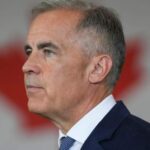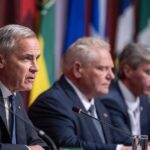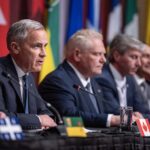In a masterful political maneuver that has left opposition parties scrambling for response, Finance Minister Mark Carney’s influence was unmistakable in Tuesday’s Throne Speech, which unveiled an ambitious economic strategy that appears to be resonating with Canadians across the political spectrum. The speech, delivered by Governor General Mary Simon, strategically blended progressive social policies with fiscal discipline—a hallmark of Carney’s economic philosophy that has effectively neutralized Conservative criticism while asserting a distinctly Canadian approach to sovereignty.
“We find ourselves at a pivotal moment in our nation’s story,” Simon stated, echoing language that Carney has consistently employed since joining Prime Minister Trudeau’s cabinet earlier this summer. The speech outlined a comprehensive strategy addressing housing affordability, healthcare funding, and climate change initiatives, while simultaneously promising fiscal restraint—a balancing act that political analysts suggest bears Carney’s distinct signature.
The political calculus behind the speech appears deliberate and effective. By embracing fiscal responsibility while maintaining core progressive values, the Trudeau government has successfully occupied the political center, leaving Conservative leader Pierre Poilievre with diminished room to maneuver. A senior Liberal strategist, speaking on condition of anonymity, confirmed this approach: “This isn’t about left versus right anymore. It’s about practical solutions for Canadians that transcend traditional political divisions.”
Perhaps most striking was the speech’s emphasis on Canadian sovereignty in an increasingly fractious global environment. With explicit references to strengthening NORAD, enhancing Arctic security, and deepening trade relationships with democratic allies, the government signaled a more assertive stance that addresses growing public concern about Canada’s place in a changing world order.
Economic experts note that Carney’s influence extends beyond mere rhetoric. “You can see his handprint in the specific proposals for a national permitting system to accelerate infrastructure projects and the creation of a Canadian sovereign wealth fund,” explained Dr. Alison Fraser, economist at the University of Toronto. “These aren’t typical Liberal policies—they reflect Carney’s understanding of how to leverage Canada’s resources for long-term economic resilience.”
The speech also introduced a new “Canadian Opportunity Agenda” that promises targeted investments in critical industries including clean energy, advanced manufacturing, and artificial intelligence—sectors where Canada can potentially establish global leadership. This approach represents a significant evolution from previous Liberal economic policies, suggesting a more strategic industrial vision that has typically been associated with Carney’s economic thinking.
Public reaction has been cautiously positive, with polling indicating broad support for the balanced approach. “Canadians are pragmatic—they want solutions that work, not ideological purity tests,” noted pollster David Hansen. “The speech addresses kitchen table concerns like grocery prices and housing while also speaking to national pride and security. That’s a powerful combination.”
Opposition parties have struggled to find effective criticism. While Poilievre attempted to dismiss the speech as “empty promises,” his attacks have lacked their usual bite. Meanwhile, NDP leader Jagmeet Singh faces the challenge of maintaining his party’s distinct identity while supporting many of the progressive elements contained in the speech.
Perhaps most significantly, the throne speech has established a clear narrative for the Liberals heading into what may be an election year—one that positions Carney as the architect of a renewed Canadian economic strategy that is neither left nor right, but distinctly pragmatic and forward-looking.
As Parliament reconvenes to debate these proposals, the question remains: has Carney’s economic vision finally provided the Trudeau government with the political reset it has desperately needed, or will the ambitious promises in the throne speech ultimately falter against the hard realities of implementation in a divided House of Commons?

























